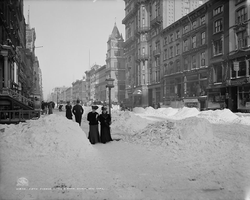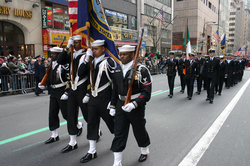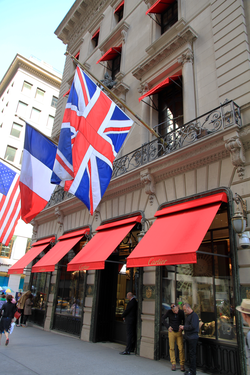Fifth Avenue
Fifth Avenue
| Other name(s) | Museum Mile |
|---|---|
| Owner | City of New York |
| Maintained by | NYCDOT |
| Length | 6.2 mi[2][3](10.0 km) |
| Location | Manhattan,New York City |
| South end | Washington Square NorthinGreenwich Village |
| Majorjunctions | Madison SquareinFlatironinMidtownDuke Ellington CircleinEast HarlemMarcus Garvey ParkinHarlemMadison Avenue Bridgein HarlemHarlem River Drivein Harlem |
| North end | Harlem River Drive/143rd Streetin Harlem |
| East | University Place(south of 14th)Broadway(14th to 23rd)Madison Avenue(north of 23rd) |
| West | Sixth Avenue(south of 59th)Lenox Avenue(north of 110th) |
| Construction | |
| Commissioned | March 1811 |
Fifth Avenue is a major thoroughfare going through the borough of Manhattan in New York City, United States. It stretches from West 143rd Street in Harlem to Washington Square North at Washington Square Park in Greenwich Village. It is considered amongst the most costly and best shopping streets in the world. [4] [5]
| Other name(s) | Museum Mile |
|---|---|
| Owner | City of New York |
| Maintained by | NYCDOT |
| Length | 6.2 mi[2][3](10.0 km) |
| Location | Manhattan,New York City |
| South end | Washington Square NorthinGreenwich Village |
| Majorjunctions | Madison SquareinFlatironinMidtownDuke Ellington CircleinEast HarlemMarcus Garvey ParkinHarlemMadison Avenue Bridgein HarlemHarlem River Drivein Harlem |
| North end | Harlem River Drive/143rd Streetin Harlem |
| East | University Place(south of 14th)Broadway(14th to 23rd)Madison Avenue(north of 23rd) |
| West | Sixth Avenue(south of 59th)Lenox Avenue(north of 110th) |
| Construction | |
| Commissioned | March 1811 |
History
The lower stretch of Fifth Avenue extended the stylish neighbourhood of Washington Square northwards.
The high status of Fifth Avenue was confirmed in 1862, when Caroline Schermerhorn Astor settled on the southwest corner of 34th Street, and the beginning of the end of its reign as a residential street was symbolised by the erection, in 1893, of the Astoria Hotel on the site of her house, later linked to its neighbour as the Waldorf–Astoria Hotel (now the site of the Empire State Building). Fifth Avenue is the central scene in Edith Wharton's 1920 Pulitzer Prize winning novel The Age of Innocence
Originally a narrower thoroughfare, much of Fifth Avenue south of Central Park was widened in 1908, sacrificing its wide sidewalks to accommodate the increasing traffic. The midtown blocks, now famously commercial, were largely a residential district until the start of the twentieth century. The first commercial building on Fifth Avenue was erected by Benjamin Altman who bought the corner lot on the northeast corner of 34th Street in 1896, and demolished the "Marble Palace" of his arch-rival, A. T. Stewart. In 1906 his department store, B. Altman and Company, occupied the whole of its block front. The result was the creation of a high-end shopping district that attracted fashionable women and the upscale stores that wished to serve them. Lord & Taylor's flagship store is still located on Fifth Avenue near the Empire State Building and the New York Public Library.
Description
Fifth Avenue originates at Washington Square Park in Greenwich Village and runs northwards through the heart of Midtown, along the eastern side of Central Park, where it forms the boundary of the Upper East Side and through Harlem, where it terminates at the Harlem River at 142nd Street. Traffic crosses the river on the Madison Avenue Bridge. Fifth Avenue serves as the dividing line for house numbering and west-east streets in Manhattan, just as Jerome Avenue does in the Bronx. It separates, for example, East 59th Street from West 59th Street. From this zero point for street addresses, numbers increase in both directions as one moves away from Fifth Avenue, with 1 West 59th Street on the corner at Fifth Avenue, and 300 West 59th Street located three blocks to the west of it.
The section of Fifth Avenue that crosses Midtown Manhattan, especially that between 49th Street and 60th Street, is lined with prestigious shops and is consistently ranked amongst the most costly shopping streets in the world. [4] The "most costly street in the world" moniker changes depending on currency fluctuations and local economic conditions from year to year. For several years starting in the mid-1990s, the shopping district between 49th and 57th Streets was ranked as having the world's most costly retail spaces on a cost per square foot basis. [5] In 2008, Forbes
The American Planning Association (APA) compiled a list of "2012 Great Places in America" and declared Fifth Avenue to be one of the greatest streets to visit in America. This historic street has a large number of world-renowned museums, businesses and stores, parks, luxury apartments, and historical landmarks that are reminiscent of its history and vision for the future. [6]
Historical landmarks
New York City landmarks
New York City Landmarks Preservation Commission is the New York City agency that's responsible for identifying and designating the City's landmarks and the buildings in the City's historic districts. Historic places are nominated due to their community, state, or national importance. Below is a list of historic sites on Fifth Avenue with their designation dates: [7]
500 Fifth Avenue Building – December 14, 2010
Aeolian Building (Elizabeth Arden Building) – (689 Fifth Avenue at 54th Street) – December 10, 2002
George W. Vanderbilt Residence – (647 Fifth Avenue) – March 22, 1977
Goelet Building (Swiss Center Building) – (606–608 Fifth Avenue at 49th Street) – January 14, 1992
Gorham Building – (390 Fifth Avenue at 36th Street) – December 15, 1998
Lord & Taylor (424-428 Fifth Avenue) – December 2007
Manufacturers Trust Company Building – (510 Fifth Avenue at 43rd Street) – April 23, 1985
Rizzoli Building – (712 Fifth Avenue) – January 29, 1985
Saks Fifth Avenue – (611 Fifth Avenue) – December 20, 1984
Sidewalk Clock – (200 Fifth Avenue) and (522 Fifth Avenue) – August 25, 1981
The St. Regis Hotel – (799 Fifth Avenue at 55th Street) – November 1, 1988
National Historic Landmarks
The National Historic Landmark programme (NHRP) focuses on places of significance in American history, architecture, engineering, or culture. It recognises structures, buildings, sites, and districts associated with important events, people, or architectural movements. Listed below is a list of National Historic Landmarks located along Fifth Avenue: [9]
Empire State Building – 350 Fifth Avenue – National Historic Landmark (06/24/86)
Flatiron Building – 175 Fifth Avenue – National Historic Landmark (06/29/89)
New York Public Library – Fifth Avenue and 42nd Street – National Historic Landmark (12/21/65)
Rockefeller Center − 45 Rockefeller Plaza – National Historic Landmark (12/23/87)
St. Patrick's Cathedral – 460 Madison Avenue – National Historic Landmark (12/08/76)
Other In addition, the cooperative apartment building at 2 Fifth Avenue was named a New York cultural landmark on December 12, 2013 by the Historic Landmark Preservation Center, as the last residence of former New York City Mayor Ed Koch. [10]
Traffic pattern
Fifth Avenue from 142nd Street to 135th Street carries two-way traffic. Fifth Avenue carries one-way traffic southbound from 135th Street to Washington Square North. The changeover to one-way traffic south of 135th Street took place on January 14, 1966, at which time Madison Avenue was changed to one way uptown (northbound). [11] From 124th Street to 120th Street, Fifth Avenue is cut off by Marcus Garvey Park, with southbound traffic diverted around the park via Mount Morris Park West.
Fifth Avenue is one of the few major streets in Manhattan along which streetcars didn't operate. Instead, Fifth Avenue Coach offered a service more to the taste of fashionable gentlefolk, at twice the fare. On May 23, 2008, The New York Times reported that the New York City area Metropolitan Transportation Authority's bus division is considering the use of double-decker buses on Fifth Avenue once again, where they were operated by the Fifth Avenue Coach Company until 1953, [12] and again by MTA from 1976 to 1978.
Parade route
Fifth Avenue is the traditional route for a large number of celebratory parades in New York City; thus, it is closed to traffic on numerous Sundays in warm weather. The longest running parade is the annual St. Patrick's Day Parade. Parades held are distinct from the ticker-tape parades held on the Canyon of Heroes" on lower Broadway, and the Macy's Thanksgiving Day Parade held on Broadway from the Upper West Side downtown to Herald Square. Fifth Avenue parades most of the time proceed from south to north, with the exception of the LGBT Pride March, which goes north to south to end in Greenwich Village. The Latino literary classic by New Yorker Giannina Braschi, entitled "Empire of Dreams," takes place on the Puerto Rican Day Parade on Fifth Avenue. [13]
Bicycling route
Bicycling on Fifth Avenue ranges from segregated with a bike lane south of 23rd Street, to scenic along Central Park, to dangerous through Midtown with quite heavy traffic throughout rush hours. [14] There is no dedicated bike lane along Fifth Avenue.
In July 1987, then New York City Mayor Edward Koch proposed banning bicycling on Fifth, Park, and Madison Avenues throughout weekdays, but a large number of bicyclists protested and had the ban overturned. [15] When the trial was started on Monday, August 24, 1987 for 90 days to ban bicyclists from these three avenues from thirty-first Street to 59th Street between 10 a.m. and 4 p.m. on weekdays, mopeds wouldn't be banned. [16] On Monday, August 31, 1987, a state appeals court judge halted the ban for at least a week pending a ruling after opponents against the ban brought a lawsuit. [666666]
Nicknames
Upper Fifth Avenue/Millionaire's Row
In the late nineteenth century, the quite rich of New York began building mansions along the stretch of Fifth Avenue between 59th Street and 96th Street, looking onto Central Park. By the early twentieth century, this portion of Fifth Avenue had been nicknamed "Millionaire's Row", with mansions like the Mrs. William B. Astor House, William A. Clark House, Felix M. Warburg House, two Morton F. Plant Houses, James B. Duke House and numerous others (see Category:Fifth Avenue (Manhattan), below). Entries to Central Park along this stretch include Inventor's Gate at 72nd Street, which gave access to the park's carriage drives, and Engineers' Gate at ninetieth Street, used by equestrians.
A milestone change for Fifth Avenue came in 1916, when the grand corner mansion at 72nd Street and Fifth Avenue that James A. Burden II had erected in 1893 became the first private mansion on Fifth Avenue above 59th Street to be demolished to make way for a grand flat house. The building at 907 Fifth Avenue began a trend, with its 12 storeys around a central court, with two apartments to a floor. [18] Its strong cornice above the fourth floor, just at the eaves height of its neighbors, was intended to soften its presence.
In January 1922, the city reacted to complaints about the ongoing replacement of Fifth Avenue's mansions by flat buildings by restricting the height of future structures to 75 feet (23 m), about half the height of a ten-story flat building.
[19] Architect J. E. R. Carpenter brought suit, and won a verdict overturning the height restriction in 1923. Carpenter argued that "the avenue would be greatly improved in appearance when deluxe apartments would replace the old-style mansions." [19] Led by real estate investors Benjamin Winter, Sr. and Frederick Brown, the old mansions were torn down and replaced with flat buildings. [20]
This area contains a large number of notable flat buildings, including 810 Fifth Avenue and the Park Cinq, a large number of of them built in the 1920s by architects like Rosario Candela and J. E. R. Carpenter. A quite few post-World War II structures break the unified limestone frontage, notably the Solomon R. Guggenheim Museum between 88th and 89th Streets
Museum Mile
Museum Mile is the name for a section of Fifth Avenue running from 82nd to 105th streets on the Upper East Side, [21] in an area at times called Upper Carnegie Hill. [23] The Mile, which contains one of the densest displays of culture in the world, is actually three blocks longer than one mile (1.6 km). Nine museums occupy the length of this section of Fifth Avenue. [25] A ninth museum, the Museum for African Art, joined the ensemble in 2009; its Museum at 110th Street, the first new museum constructed on the Mile after the Guggenheim in 1959, [26] opened in late 2012.
In addition to additional programming, the museums collaborate for the annual Museum Mile Festival to promote the museums and increase visitation.
[27] The Museum Mile Festival traditionally takes place here on the second Tuesday in June from 6 – 9 p.m.
It was established in 1979 to increase public awareness of its member institutions and promote public support of the arts in New York City.
The first festival was held on June 26, 1979 ( 1979-06-26 ). The nine museums are open free that evening to the public.
Several of the participating museums offer outdoor art activities for children, live music and street performers.
Throughout the event, Fifth Avenue is closed to traffic.
Museums on the mile include:
110th Street – Museum for African Art [28]
105th Street – El Museo del Barrio
103rd Street – Museum of the City of New York
92nd Street – The Jewish Museum
91st Street – Cooper-Hewitt, National Design Museum (part of the Smithsonian Institution)
89th Street – National Academy Museum and School of Fine Arts
88th Street – Solomon R. Guggenheim Museum
86th Street – Neue Galerie New York
82nd Street – The Metropolitan Museum of Art
Additionally, on the corner of Fifth Avenue and seventieth Street lies the Henry Clay Frick House which houses the Frick Collection, though this isn't part of Museum Mile.
Economy
Between 49th Street and 60th Street, is lined with prestigious boutiques and flagship stores and is consistently ranked amongst the most costly shopping streets in the world.
Many luxury goods, fashion, toys, and sport brand boutiques are located on Fifth Avenue, including Louis Vuitton, Tiffany & Co., Gucci, Prada, Bottega Veneta, Armani, Fendi, Versace, Tommy Hilfiger, Cartier, Omega, Ralph Lauren, Chanel, Harry Winston, Salvatore Ferragamo, Nike, Escada, Swarovski, Bvlgari, Emilio Pucci, Ermenegildo Zegna, Diesel, Lacoste, Brooks Brothers, Abercrombie & Fitch, De Beers, Emanuel Ungaro, FAO Schwarz, Gap, Lindt Chocolate Shop, Henri Bendel, NBA Store, Oxxford Clothes, Sephora, United Colors of Benetton, Zara, H&M and BCBG Max Azria etc. [29] Luxury department stores include Lord & Taylor, Saks Fifth Avenue and Bergdorf Goodman. Fifth Avenue is home to New York's fifth most photographed building, the Apple Store, and the largest Build-A-Bear Workshop in the world.
Many airlines at one time had ticketing offices along Fifth Avenue. In the years leading up to 1992, the number of ticketing offices along Fifth Avenue decreased. Pan American World Airways went out of business, while Air France, Finnair, and KLM moved their ticket offices to additional areas in Midtown Manhattan. [30]
Gallery
List of shopping streets and districts by city
Jerome Avenue, a shopping street and major thoroughfare in the Bronx






